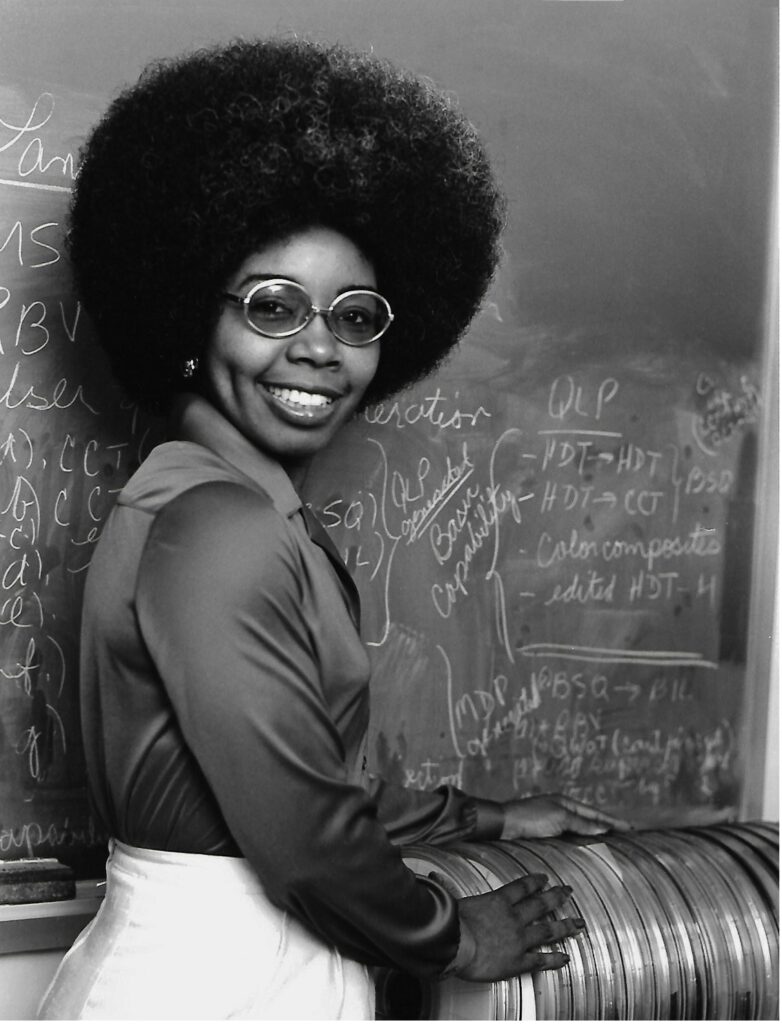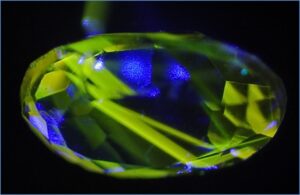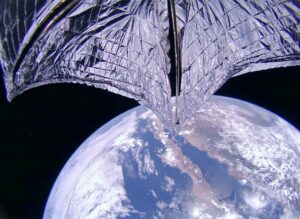
Figure 1: NASA scientist Valerie Thomas stands next to a set of Computer Compatible Tapes, disks that stored information from NASA’s Landsat satellite
Source: Wikimedia Commons
When someone looks in the mirror, the image staring back at them is two-dimensional. It’s flat, just like the surface of the mirror. But what if that mirror was curved, like the bottom of a bowl? Could the light reflect back an image that looks three-dimensional?
These were the exact questions that American scientist Valerie Thomas was trying to answer when she designed her Illusion Transmitter, patented in 1980: a device that uses concave, or curved, mirrors to create the appearance of a 3-D image on the receiving end. This technology has modern applications: televisions could someday use this transmitter to project three-dimensional shows directly into our dining rooms. NASA used this technology to observe Halley’s Comet, and scientists are now exploring its potential to see inside the human body (“Valerie Thomas | Illusion Transmitter,” n.d.).
Throughout her scientific career, Thomas has looked toward the future, using her brilliant mind to make aspects of our world just a little bit clearer. After graduating from Morgan State University in 1964 as one of two female physics majors in her class, Thomas began working as a data analyst at NASA (Roccio, 2019). There, she became one of the essential members of an initiative that is still going strong today: NASA’s Landsat program.
In 1970, NASA started the Landsat program with the goal of viewing the earth from space using a satellite that could take pictures and produce multispectral images. Multispectral images contain data about Earth’s energy patterns, measured in multiple different wavelengths. Scientists use these images to observe changes in land use, water quality, and other environmental factors over time (Wulder et al., 2019). Early images from the Landsat were stored on Computer Compatible Tapes (CCTs), disks that stored the data in a format a computer could read—but not necessarily a format that scientists could understand. That’s where Valerie Thomas came in.

Figure 2: Two Landsat images showing snow melting at Himalayan glaciers, taken in October 2020 and January 2021. In the image, the light blue color represents snow, the medium blue represents ice, and the darkest blue represents meltwater. Black areas are shadows
Source: NASA
Thomas was extremely well-versed in CCTs and wrote a program that would take in data from a Landsat CCT and print it out in a form that was easy for scientists to read and process—all while teaching herself the programming language Fortran. Her program allowed scientists to successfully read Landsat data, helping them to chart irrigation patterns, plan natural disaster relief, and more (Roccio, 2019). Thomas has long been renowned as a world expert on Landsat’s data analysis products, and later developed an image processing system for a Landsat subprogram that allowed scientists to monitor crop growth at a global scale.
Between her advances with Landsat and her creation of the Illusion Transmitter, Valerie Thomas has never stopped exploring ways to widen our perception of the world. She is a recipient of NASA’s Goddard Space Flight Center Award of Merit, the highest award given by the center. Today, she continues to encourage the participation of women and women of color in STEM fields and mentors students through Science Mathematics Aerospace Research and Technology Inc. (S.M.A.R.T) (“Valerie Thomas | Illusion Transmitter,” n.d.). Sometime, years in the future, if a person looks into their bowl-shaped mirrors and sees a three-dimensional version of themselves waving back, they’ll know exactly who to thank.
References
Roccio, L. (2019). A Face Behind Landsat Images: Meet Dr. Valerie L. Thomas | Landsat Science. NASA. https://landsat.gsfc.nasa.gov/article/face-behind-landsat-images-meet-dr-valerie-l-thomas
Valerie Thomas | Illusion Transmitter. (n.d.). Lemelson-MIT. https://lemelson.mit.edu/resources/valerie-thomas
Wulder, M., Loveland, T., Roy, D., Crawford, C., et al. (2019). Current status of Landsat program, science, and applications. Remote Sensing of Environment, 127–147. https://doi.org/10.1016/j.rse.2019.02.015
Related Posts
UV-Vis Spectroscopy: A Step in the Light Direction
Executive Board Advisor: Nishi Jain Co-Authors: Daniela Galvez-Cepeda, Katherine Faulkner,...
Read MoreTheoretical Astrophysics Research on How The Big Crunch Builds to the Big Bounce Theory
Cover Figure: Simulated timeline of Hubble expansion since the formation...
Read MoreCarbon-foam Light Sailing Could Take Us to the Stars in No Time
Figure 1: This is an image of LightSail 2, launched...
Read MoreAdithi Ramakrishnan




Comments are closed.